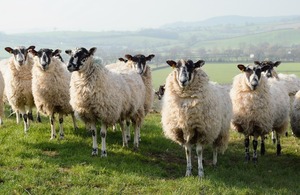Bluetongue: latest situation
Overview of current bluetongue cases, risk level, vaccinations and restrictions.

Contents:
- Latest updates
- Total number of cases
- Risk level
- Control zones
- Moving animals and animal products
- Vaccination and biosecurity
- Livestock identification and movement rules
- Importing animals and animal products
- Webinars, leaflets, videos and posters
- Defra’s bluetongue control strategy
Be vigilant for signs of bluetongue and report it if you suspect it.
Latest updates
1415 August 2025
OneThree new casecases of BTV-3 was were confirmed on 1415 August 2025.2025:
Three
- one
farmedsheepdeerEastBerkshireSussexwas confirmed positive following a report of suspicious clinical signs - 2 yearling cattle in Hampshire were confirmed positive following a non-negative pre-movement
test.test - one sheep in Oxfordshire was confirmed positive following a report of suspicious clinical signs
1114 August 2025
One new case of BTV-3 was confirmed on 1114 August 2025.
OneThree sheepfarmed deer in BuckinghamshireEast wasSussex were confirmed positive following a reportnon-negative ofpre-movement suspicious clinical signs.test.
711 August 2025
TwoOne new casescase of BTV-3 were was confirmed on 711 August 2025:2025.
oneOne
ewesheep inDorsetBuckinghamshire was confirmed positive following a report of suspicious clinicalsignsonelambinHampshirewasconfirmedpositivefollowingareportofsuspiciousclinicalsigns
Restricted zone
The restricted zone for bluetongue was extended to cover all of England on 1 July 2025. You can now move animals within England without a specific bluetongue licence or pre-movement testing.
You will need a specific licence to freeze germinal products (semen, ova and embryo) anywhere in England and testing will be required. Keepers will be responsible for the cost of sampling, postage and testing. Further detail can be found in the declaration.
Check the guidance on:
- moving animals in England - including farms, markets, shows and slaughterhouses
- moving animals from England to Scotland
- moving animals from England to Wales
- collecting, freezing and moving germinal product in England
Total number of cases
The total number of BTV-3 cases in Great Britain for the 2025 to 2026 vector season (since July 2025) is 13.16. All cases have been in England.
The location of all premises in Great Britain where one or more animals have tested positive by PCR to bluetongue serotype 3 or serotype 12 is available on the bluetongue case map.
Read the details of each case.
Risk level
The risk of transmission via infected midges is now considered to be very high in England and most of Great Britain.
Control zones
Check if you’re in a zone on the bluetongue zone map.
Read the details of each zone.
Moving animals and animal products
Find out about:
- moving animals within the restricted zone
- general licences to move animals and germinal product from the restricted zone to Scotland or Wales
- moving, freezing and storing germinal product
Vaccination and biosecurity
Find out about:
Livestock identification and movement rules
Find out about:
- keeping cattle, bison and buffalo in England and Wales
- keeping sheep and goats in England
- keeping deer in England: tagging, movement and record keeping rules
Contact the Animal and Plant Health Agency (APHA) if you keep camelids (such as llamas or alpacas) or you’re unsure about the rules.
Importing animals and animal products
Check the rules on imports, exports and EU trade of animals and animal products.
Webinars, leaflets, videos and posters
Watch recordings of bluetongue webinars.
Find leaflets, videos and posters about bluetongue.
Defra’s bluetongue control strategy
Defra controls cases of bluetongue by following the Bluetongue: disease control framework in England
Updates to this page
-
Three new cases of BTV-3 were confirmed on 15 August 2025: one sheep in Berkshire; 2 yearling cattle in Hampshire; and one sheep in Oxfordshire.
-
One new case of BTV-3 was confirmed on 14 August 2025. Three farmed deer in East Sussex were confirmed positive following a non-negative pre-movement test.
-
Added information about cases of bluetongue that were confirmed on 6, 7 and 11 August 2025.
-
First published.